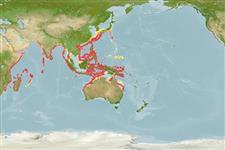>
Carangiformes (Jacks) >
Carangidae (Jacks and pompanos) > Caranginae
Etymology: Decapterus: Greek, deka = ten + Greek, pteron = wing, fin (Ref. 45335).
More on author: Bleeker.
Environment: milieu / Klimaatzone / Diepte / distribution range
Ecologie
marien rifbewoner; diepte 100 - 300 m (Ref. 3197), usually 150 - 300 m (Ref. 3197). Deep-water; 38°N - 26°S, 34°E - 148°E
Indo-West Pacific: East Africa to the Philippines, north to southern Japan, south to Western Australia.
Lengte bij maturiteit / Grootte / Gewicht / Leeftijd
Maturiteit: Lm 17.2 range ? - ? cm
Max length : 45.0 cm TL mannelijk / geslacht onbekend; (Ref. 3197); common length : 30.0 cm FL mannelijk / geslacht onbekend; (Ref. 3287)
Dorsale stekels (totaal) : 9; Dorsale zachte stralen (totaal) : 28 - 29; Anale stekels: 3; Anale zachte stralen: 22 - 25. Deep bodied compared to similar species (Ref. 48635). Body color bluish green above, silvery below; caudal fin bright red. Sometimes a yellow mid-lateral stripe (Ref. 48635). Opercle with a small black spot; margin of opercular membrane smooth. 31-38 scutes.
Body shape (shape guide): fusiform / normal; Cross section: compressed.
Adults are found in deep waters. They feed on small planktonic invertebrates (Ref. 5213). Occasionally seen in small groups along reef slopes at moderate depths. Mainly known from trawls and shows red tail after capture (Ref. 48635).
Paxton, J.R., D.F. Hoese, G.R. Allen and J.E. Hanley, 1989. Pisces. Petromyzontidae to Carangidae. Zoological Catalogue of Australia, Vol. 7. Australian Government Publishing Service, Canberra, 665 p. (Ref. 7300)
Status op de Rode Lijst van het IUCN (Ref. 130435: Version 2025-1)
Gevaar voor de mens
Harmless
Gebruik door de mens
Visserij: commercieel
Tools
Speciale rapporten
Download XML
Internetbronnen
Estimates based on models
Preferred temperature (Ref.
123201): 11.5 - 22.4, mean 15 °C (based on 274 cells).
Fylogenetische diversiteitsindex (Ref.
82804): PD
50 = 0.5005 [Uniqueness, from 0.5 = low to 2.0 = high].
Bayesian length-weight: a=0.01318 (0.00891 - 0.01950), b=3.00 (2.88 - 3.12), in cm total length, based on LWR estimates for this species & Genus-body shape (Ref.
93245).
Trofisch niveau (Ref.
69278): 3.4 ±0.45 se; based on food items.
Weerstandsvermogen (Ref.
120179): Gemiddeld, minimale populatieverdubbelingstijd 1,4-4,4 jaar (K=0.63).
Fishing Vulnerability (Ref.
59153): Low vulnerability (25 of 100).
🛈
Nutrients (Ref.
124155): Calcium = 58.6 [15.2, 161.2] mg/100g; Iron = 1.09 [0.40, 2.96] mg/100g; Protein = 20.1 [18.6, 21.6] %; Omega3 = 0.31 [0.14, 0.71] g/100g; Selenium = 17.3 [5.0, 56.2] μg/100g; VitaminA = 20.4 [3.5, 129.2] μg/100g; Zinc = 0.478 [0.264, 0.847] mg/100g (wet weight);
